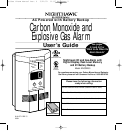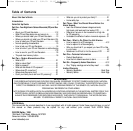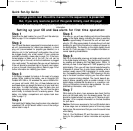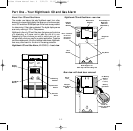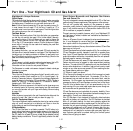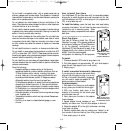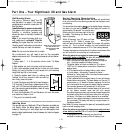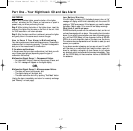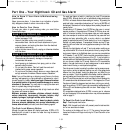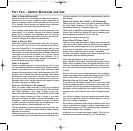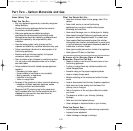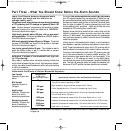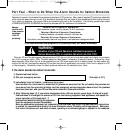
About this User’s Guide
Notice we call this booklet a “User’s Guide” and not an “Owner’s
Manual.” This is because our intention is you use this guide just
as you will be using your Nighthawk CO and Gas alarm. Keep
the guide in a handy location and refer to it when you have ques-
tions about your CO and Gas alarm, its functions and features.
Part One
Your Nighthawk Carbon Monoxide and Explosive Gas
Alarm, covers the unique features of your Nighthawk carbon
monoxide and explosive Gas alarm, how and where to install it,
as well as information on testing and maintaining your unit.
Part Two
Carbon Monoxide and Gas contains valuable information
about carbon monoxide (CO) and gas. From discovering the
most common sources of CO in your home to recognizing the
symptoms of CO poisoning, this section provides tips and infor-
mation that could help protect your family.
Part Three
What You Should Know Before the Alarm Sounds, pro-
vides a common sense approach to understanding the difference
between low level CO readings, high levels and emergency situ-
ations. This section also describes the effects of exposure to CO
levels over time and when your Nighthawk CO and Gas unit will
alarm.
Part Four
What to do When the Unit Alarms, gives you step-by step
information on how to respond to the different alarm situations.
Also covered is whom to call for help if you think you have CO
or Gas in your home.
Part Five
Technical Information, covers the technical specifications of
your Nighthawk CO and Gas alarm.
Part Six
Frequently Asked Questions, contains the most commonly
asked questions about our alarms. Part six was written by
KIDDE Safety customer service representatives who handle thou-
sands of calls per month, year-round. This section provides you
with answers and tips that will most likely answer any questions
you might have after reading this user’s guide.
This Nighthawk carbon monoxide (CO) alarm is an important part of
your family’s home safety plan. As a new owner of a CO and Gas
alarm, there are some basic facts you should know for your protec-
tion and convenience.
Carbon monoxide (CO) is invisible, odorless, tasteless and non-irri-
tating–completely undetectable to your five senses. That’s why it’s so
important to your safety that you have a carbon monoxide and
explosive Gas alarm.
Natural Gas is typically supplied through a main utility line con-
nected to your home. If you do not live in a rural area you are like-
ly to be a user of natural Gas. It is the dominant energy used for
home heating with about 55 percent of American homes using Gas.
Natural Gas is a fossil fuel comprised almost entirely of Methane.
Methane is much lighter than air and will rise rapidly in air. If you are
a user of natural Gas, we recommend you mount your Nighthawk
unit 12 inches away from the ceiling (using retractable cord feature)
to ensure the earliest opportunity to detect a leak.
Propane is typically supplied to homes via delivery truck in liquid
form and stored near the home in propane tanks. Propane is used by
homes in rural areas that do not have natural Gas service. Since
propane is the most commonly used liquefied petroleum Gas (LPG),
“propane” and LP-Gas are often used synonymously. Unlike natural
Gas, propane is much heavier than air and will collect at lower lev-
els. If you are a user of propane, we recommend you mount your
Nighthawk near the floor (using the direct plug-in feature) to ensure
the earliest opportunity to detect a leak.
Both Propane and Natural Gas are colorless and odorless. For safety
reasons, an ordorant (Mercaptan) is added so that any leak can be
detected by smell. The common detection threshold for smelling the
Gases is around 20% of the lower explosion limit (LEL). This can
vary greatly depending on the individuals sense of smell and how
long they have been exposed to it. The LEL of each of these gases
defines the bottom range of flammability for the Gas. Your
Nighthawk is calibrated to alarm before 25% of the LEL of either Gas
detected. Therefore, it is possible that you may smell Gas before
the alarm is activated.
If you are not sure which Gas your home uses, contact your
utility company.
Please take the time to read this guide from cover to cover, to famil-
iarize yourself with the facts about carbon monoxide, natural Gas and
propane. Know how your new unit works, and what to do if it
alarms. Then, find a handy place to keep the guide so it will be read-
ily available in the future when you have a question. You might want
to write down KIDDE Safety’s toll-free customer service number and
keep it with your other important phone numbers for the same rea-
son.
Thank you for making Nighthawk a part of your complete home
safety program. With proper installation and use, your new
Nighthawk CO and Gas alarm should provide you with years of
dependable service.
Introduction
i
CO/Gas Alarm Manual Rev. C 3/21/01 11:37 AM Page 4



